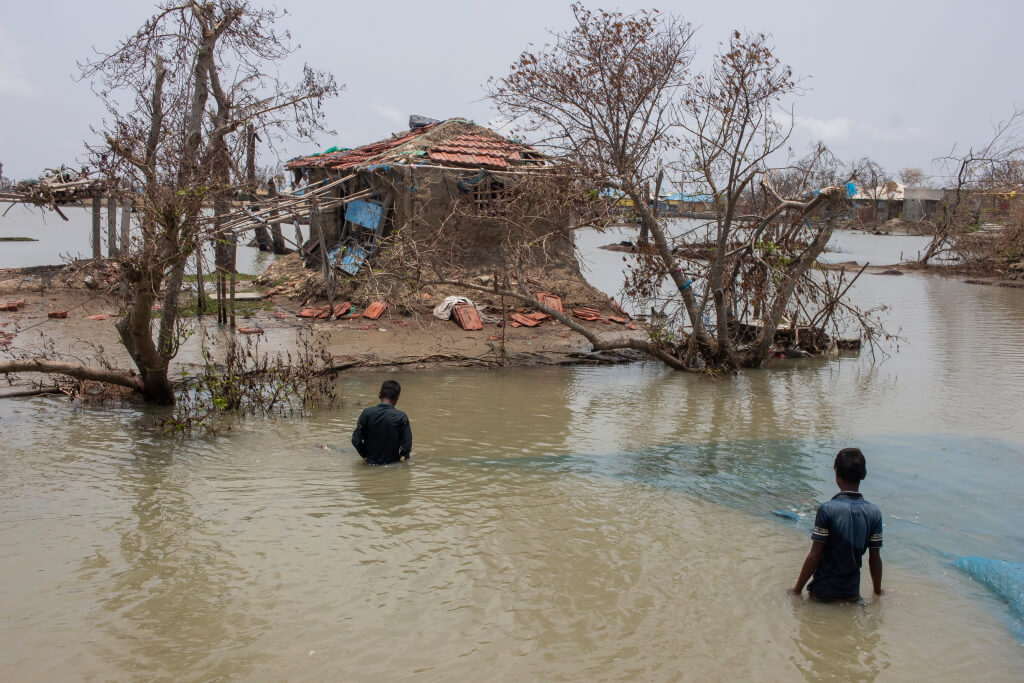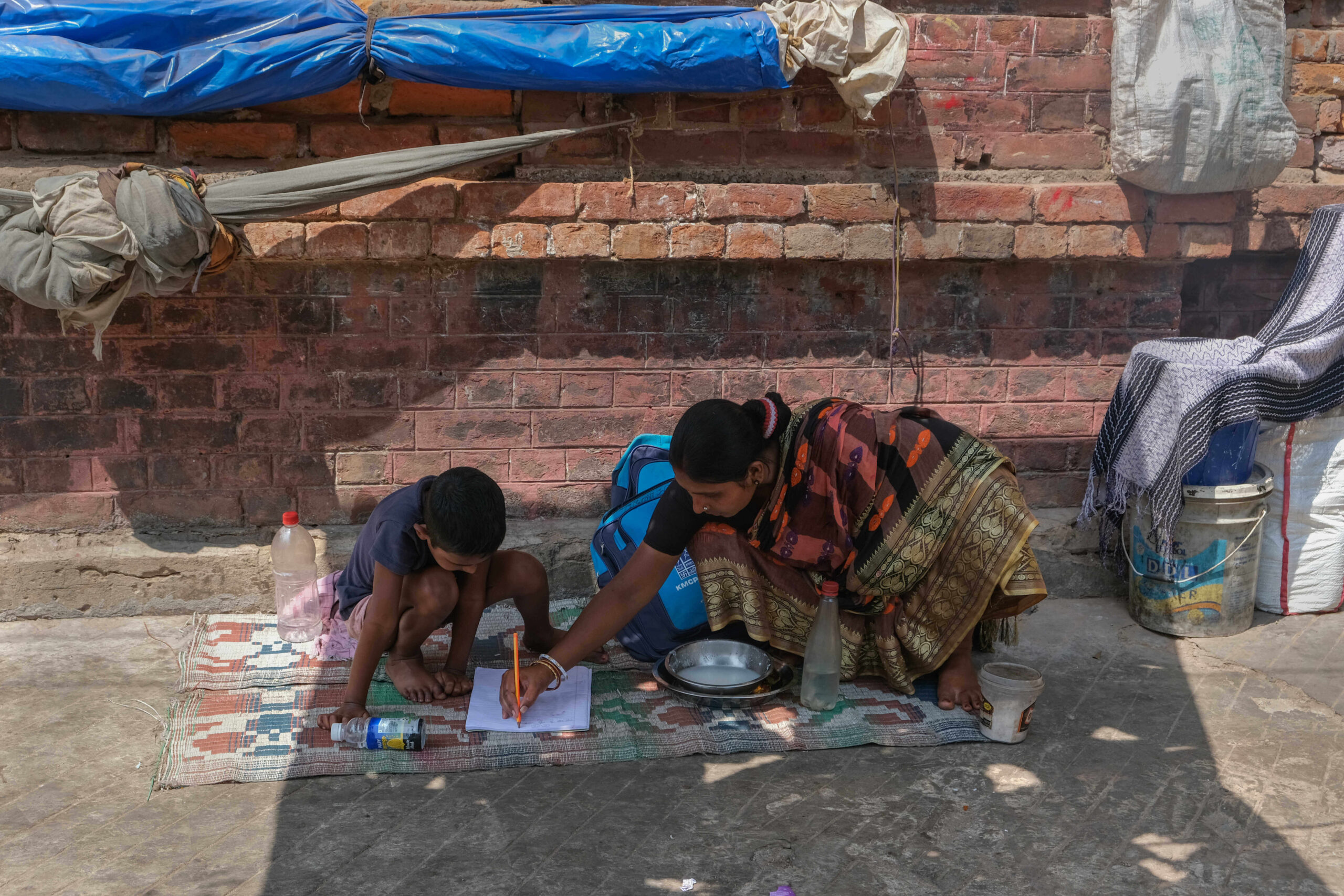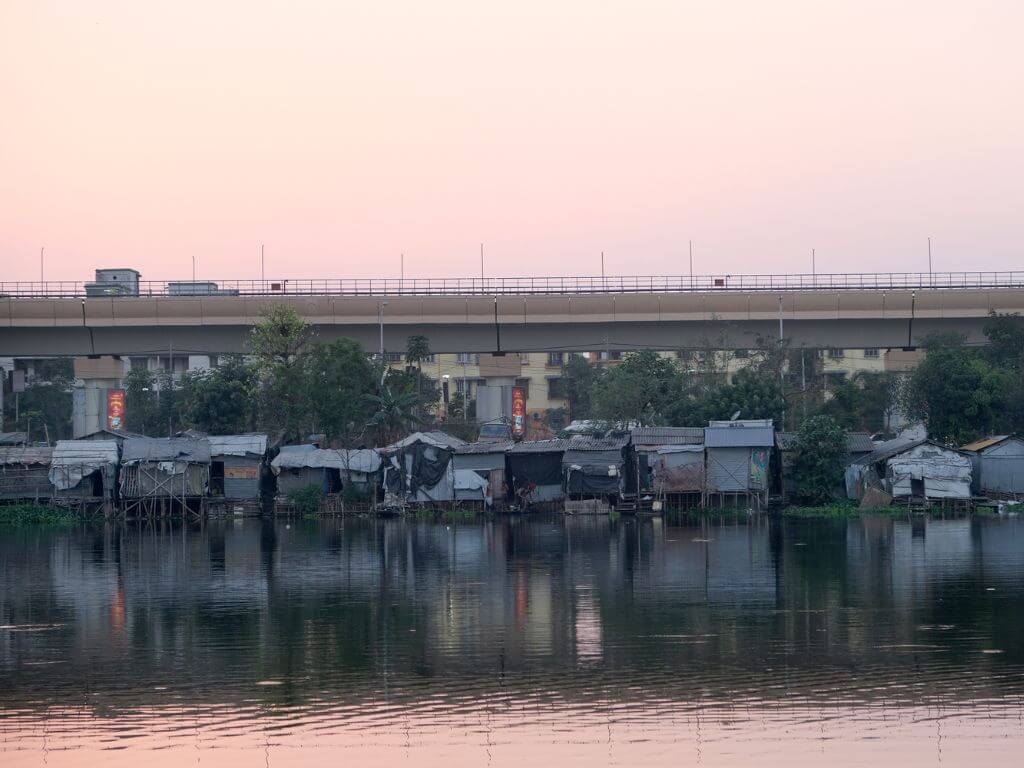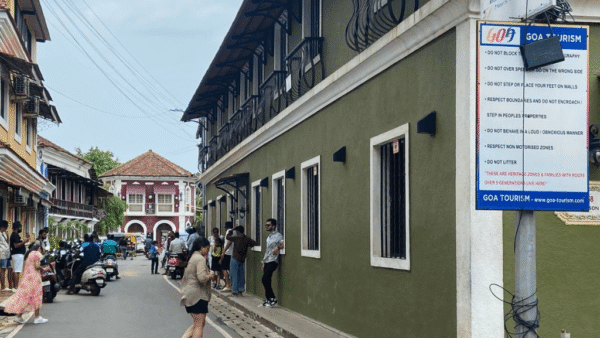Ambika Bor, 23, who lives in a slum along a lake near Eastern Metropolitan (EM) Bypass in Kolkata, is anxious. The authorities, she says, have asked her and others in the slum to not throw garbage into the lake, remove any extensions they may have made of their homes near the water, and keep the area in front of their little houses clean. Bor, and her neighbours, have heard of the beautification that the authorities want to do in the area.
“I don’t know if they want to remove us from here, but if the government wants to beautify the area, we need to be careful,” says Bor, who came to live here five years ago after her marriage. Bor’s family is among the 50-odd families who moved to Kolkata, capital of West Bengal, from different parts of the Sundarbans about five years before that after their homes and fields were ravaged by cyclones.
Covering 40,000 square kilometres, the Sundarban delta stretches across Bangladesh in the east and West Bengal in the west. Over the past two decades, the water level in the delta has risen by an average of three centimetres (approximately 1.2 inches) a year, well above the global average. The region has witnessed 16 major cyclones in recent years, the latest being Yaas in 2021.
The India Meteorological Department report (IMD) has termed the Sundarbans as the cyclone capital of India. As Climate Change exacerbates the situation in the Sundarbans, literally the “beautiful forest” in Bengali, lacerating across the complex maze of mangroves and waterways, people who have lived around in the area have been forced to look for alternatives. They invariably reach Kolkata, the city, they believe, offers work and hope. However, life in the city is as difficult and their trials begin with housing; most end up living in informal settlements such as slums and on pavements.
The Bors also came to a little hut when they migrated. They eventually extended their hut by building a small room near the lake water but it was demolished. They now live in one room which measures 10×10 square feet and can barely squeeze in a bed. “Living here means living with mosquitoes. The waste that’s thrown into the water makes matters worse but no municipal workers come to this side of the road to clean or collect garbage,” says Bor, mother of a four-year-old girl. Her husband could find work as a cycle-rickshawalla but he had to sit at home during the pandemic. He now works as a daily wage labourer, earning Rs 300 to Rs 400 a day, and the family lives off that – hand to mouth.

Photo: Subhajit Naskar
Cyclone-ravaged home, unwelcome city
Most migrants who left behind the Sundarban delta in the last decade are those affected by Cyclone Aila of 2009 and after. As much as 1,05,075 hectares of land was inundated with saline water during that cyclone which made national and international headlines, severely affecting Gosaba, Basanti, Namkhana, Sagar, and Patharpratima blocks, according to the Department of Horticulture and Agriculture in South 24 Parganas district.
The saline floodwater broke the embankments and flooded the paddy fields with standing crop back then. People were reduced to begging for alms after the emergency relief had tapered off. Many lost members of their families. With neither loved ones nor land to hold them back in the delta, and the floods becoming more frequent or intense, they began to slowly migrate to Kolkata.
In the city, unused to its demands and way of life, unable to afford anything better, they put up tarpaulin tents wherever they could find some space and started looking for work in the newly extended portion of the city. Jaydeb Gayen was among them. Gayen, 50, recalls leaving his home in Kultali in the South 24 Parganas after the cyclone and taking refuge in Kolkata as migrants from at least six neighbouring villages did. He found work at construction sites and put his roots down in the city.
“The saline water back there wreaked havoc on agriculture. Those who could sustain families by growing multiple crops earlier could hardly earn anything. More people started shifting to the city,” he says. In Kolkata, families such as his were asked to move, go away from wherever they made their shanty homes.
“We were threatened and asked to leave but we had nowhere to go. Moreover, we had steady work here as there was a lot of construction going on. Settling somewhere far could mean finding no work.” One day, when he came back from his construction site, Gayen found that the huts had been demolished. The families rebuilt them. “You never know (when demolition happens again),” he says.
Migrants’ Right to the City
The migrants’ Right to the City is not even a subject discussed in any quarter when there are no clear assessments of the number of climate migrants in the city. It is assumed that groups of migrants merge into the some of over 3,000 informal settlements or slums in the greater Kolkata area but surveys have failed to identify climate migrants and come up with a head count. Many of the migrants are scared to even identify themselves and lose their little hut without amenities given that they live in semi-legal housing which can be demolished any day. They also fear being identified as a Bangladeshi immigrant which could not only render them homeless but also land them in jail.
The public or open space near Calcutta University and Calcutta Medical College has become the home for most migrants from the villages of Jaynagar 1 block in South 24 Parganas. Some have been living here for more than 30 years, some moved to Kolkata after cyclone Aila while others more recently. There are rows of people living on the pavements in College Street, the northern side of the city and also one of its oldest parts, where even basic sanitation comes at a fee – they have to pay Rs 10 for a bath and Rs 2 for the toilet at the public toilet block.
A few are even born here in the informal settlements of Kolkata with no ties back home. They do not know what their families did back in Jaynagar or what life was like near the Sundarbans. However, their families cannot think of returning home even though they may be able to access the rural housing scheme, the Mahatma Gandhi National Rural Employment Guarantee Scheme (MGNREGS) and so on. “When we go to the village and ask for these benefits, we are told we don’t live there. Here, the police tell us to go home. There is nothing to eat in our village,” says Anowara Sardar, in her thirties, who moved to Kolkata after Cyclone Aila.
When identification itself presents an issue, when they are treated as illegal occupants or encroachers, their right to basic amenities in the city is undermined. Migration to Kolkata may not be the solution to the problems they face in the Sundarbans but once here, their struggle to live and earn makes them a vulnerable group in the city, often exploited and used by political forces as vote banks.
A recent study[1] on migration and urban governance in Kolkata states that since 2000, a stream of climate migrants from nearby areas of the Sundarbans have been added to the migrant pool of the city. “Kolkata’s urban margins, where most of the newly arriving poor migrants live, have been rapidly transforming and are at the centre of urban politics discourse. A complicated narrative unfolds between urban governance actors who adopt a neo-liberal world city aspiration for Kolkata and the governed … Literature shows that where such interactions are steered by urban governance, the result can be a large-scale violation of democratic rights, evictions, anti-eviction movements and negotiations,” it states.

Photo: Subhajit Naskar
No home to call their own
Climate migration to Kolkata is not a new phenomenon and this makes the apathy towards them worse, says Ritajyoti Bandhopadhyay, assistant professor of history and political economy, Indian Institute of Science Education and Research. “A series of floods and droughts between 1966 and 1968 in the Sundarbans region led to a wave of migration of thousands of people, most of them Dalits, to Kolkata. They started living on the pavements. We did not call it climate migration then because we weren’t using the term,” says Bandhopadhyay.
Apart from all the usual challenges that the homeless or those in slums face, the city poses unique problems for the homeless, says Bandhopadhyay, who has worked extensively with hawkers and pavement dwellers in Kolkata. “One of the key issues is inundation. Water-logging is an issue in other parts of the country too but this level of frequent inundation is rarely seen anywhere else…this inundation has meant many a hazard for people on the streets, from electrocution to water-borne diseases.”
After the Amphan cyclone in May 2020, as relief supplies were being loaded into trucks to be sent to different blocks in the Sundarbans, relief workers encountered a strange problem. “One woman from the pavement came to us saying her family was from the Sundarbans too, and would they not get help because they were in the city,” recalls Sayan Chakraborty, a volunteer of the Quarantined Student Youth Network. “This was an eye opener for us – the crisis of the Sundarbans is in Kolkata too. Amphan had left the city in a bad shape with waterlogging and fallen trees everywhere. These people did not even have a place to sleep,” he says.
The COVID-induced lockdown and then Amphan added to the woes of the city’s migrants who have been surviving on the margins. “Our incomes have dipped so much that people are scared to loan even Rs 10 because they know it won’t be returned. I know many people from the slums in the Nonadanga area near the EM Bypass who have had to go back home,” says Jagadish Shikari, who migrated to Kolkata after the 1988 flood. He now runs a small grocery shop in Nonadanga.
This area in Nonadanga had seen a huge protest in 2012 when the government wanted to remove the people who had set up makeshift houses in the open lands. Since then, some of the migrants like Shikari have become voters and residents with land deeds. But many others still fear being evicted any moment. Back in the village they are told they have no rights there as they did not live there any longer. “Despite that, a lot of people are going back as surviving in the city is becoming more difficult. I don’t know how long they will be able to survive back home, there is nothing there either,” he says.
Grim future as Kolkata becomes “the sink”
The West Bengal State Action Plan on Climate Change, 2017, predicts further intrusion of saline water in both North and South 24 Parganas which includes the entire Sundarban delta on the Indian side. This is likely to lead to further loss of agricultural land and, consequently, increased migration to cities like Kolkata.
The Intergovernmental Panel on Climate Change (IPCC) pointed out this year that global surface temperature will continue to increase till at least the mid-century under different scenarios of emissions, implying an irreversible situation as of now. For the Sundarbans, the prediction is of up to 60 centimetres rise in the sea level by the end of the century, displacing millions in both India and Bangladesh. The report underscored that migration is not a feasible adaptation strategy in India as it deepens Climate Change-related injustice; states lacked the capacity and resources to effect a smooth transition for Climate migrants.
The report also found that Climate Change-induced soil salination in the Sundarbans is burdensome for women who are forced to fetch clean drinking water from farther off areas. While the report noted that India’s National Action Plan on Climate Change included climate policies that focus on women, it pointed out that the “mere inclusion” of women in national and sub-national planning was insufficient and had not resulted in “substantial gender-transformative action”.
The climate crisis or resulting migration found hardly any mention during the civic body election in Kolkata in December 2021. But the city cannot afford to not have urban development plans or policies which do not factor in the future climate migration. “Kolkata will be the sink of climate migration,” says Bandhopadhyay. “It is time to design our policies in this context…The expanding city will have to consider Climate migration and allocate space for them who are highly vulnerable to evictions, health issues, tree falls and severe pollution. Our policies need to be designed to factor these in. It is time that climate justice becomes a part of the discussion.”
Dipanjan Sinha is a Kolkata-based independent writer who focuses on environment, politics, culture and their intersections. He has written for national and international publications on these themes. When not working, you can find him strolling in old lanes, appreciating street food and urban history.
Cover photo: Subhajit Naskar




